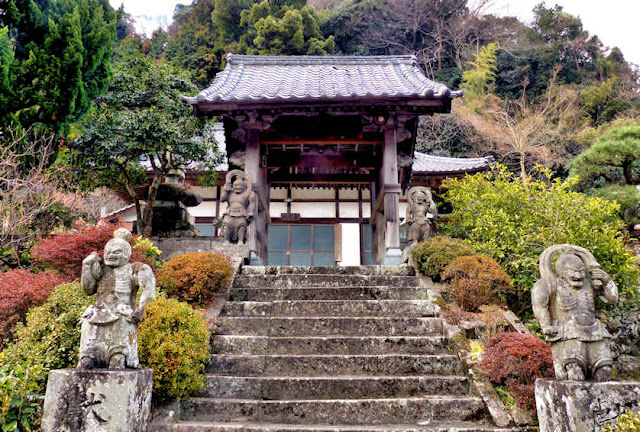Monjusenji is temple number 4 on the Kyushu Fudo Myoo Pilgrimage.
Located high in the remote mountains of the Kunisaki Peninsula, it lies to the NE of the
highest point, Mount Futago.
It is part of the ancient Shugendo cultic system known as Rokugo Manzan, a mix of Usa Hachiman and Tendai Buddhism. Monjusenji is number 25 on the ancient Kunisaki Shugendo Pilgrimage.
However, whereas most of the temples associated with Rokugo Manzan claim their origin in the early 8th century with a monk named Ninmon, Monjusenji is older and claims to have been founded in the mid 7th century by the legendary En no Gyoja.
This makes it the oldest of what are now known as the Rokugo Manzan temples.
Halfway up the steps is the first group of buildings, and here can be found the Fudo statue that is part of the Kyushu Fudo Pilgrimage.
There are several other statues and altars in this small group of buildings and in fron is a very tall, stone stupa, aboiut 8 meters high and possibly the tallest in all Japan.
Further up the steps is the main hall, the Monju-do, enshrining Monju Bosatsu. Monjusenji is considered one of the top 3 Monju temples in Japan.
Known as the Bodhisattva of Wisdom, Monju is often prayed to for academic success.
Monju is often depicted riding a shishi or lion.
A sacred spring flows from the cave behind the main hall and the area around thetemple is filled with huge, ancient trees and towering rock formations.
A group of ema votive plaques, many asking for academic success. The second photo below an ema of Monju Bosatsu.
In a cave two statues of En no Gyoja, the legendary founder of the temple, is srrounded by numerous Fudo Myo statues.
Below is a statue of Gensan Daishi, a name of Ryogen the great Tendai priest of the 10th century. Also referred to as Tsuno Daishi and Oni Daishi, his likeness is commonly found on ofuda from temples to protect against misfortune.
Below is a statue of Monju Bosatsu, but this is not the honzon. The honzon is a "secret Buddha" and only opened every 12 years, in the Year of the Rabbit.
Below are examples of the unique style of masks found in the Kunisaki area.
Below is a goma ceremony being performed. Usually done on the 25th of each month, I was visiting on January 3rd, so I suspect special goma are performed for the new year.
Below a few of the rakan statues in the rock face near the main hall.































































